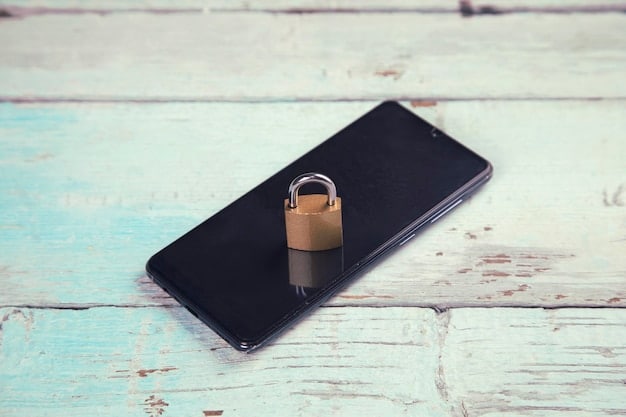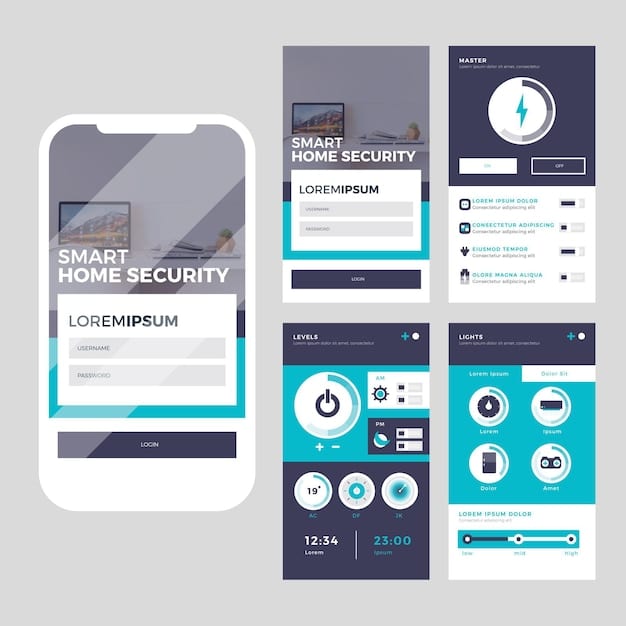Secure Your IoT Devices: A 2024 Guide for US Consumers

Anúncios
Securing your IoT devices from hacking in 2024 requires a multi-faceted approach, including strong passwords, regular software updates, network segmentation, and awareness of common vulnerabilities to protect your personal data and privacy.
In 2024, the proliferation of Internet of Things (IoT) devices in US homes presents significant security challenges. This comprehensive guide, **How to Secure Your IoT Devices from Hacking in 2024: A Comprehensive Guide for US Consumers**, will provide actionable strategies to safeguard your smart devices and protect your personal data from cyber threats.
Anúncios
Understanding the IoT Threat Landscape in 2024
The Internet of Things (IoT) has revolutionized how we live, offering convenience and connectivity. However, this interconnectedness also exposes US consumers to a growing threat landscape. Understanding these threats is the first step in securing your IoT devices.
Common IoT Hacking Methods
Hackers employ various methods to compromise IoT devices, ranging from exploiting weak passwords to leveraging software vulnerabilities.
Anúncios
- Default Passwords: Manufacturers often set default passwords that are easily guessable. Failing to change these passwords leaves devices vulnerable.
- Software Vulnerabilities: Unpatched software can contain security flaws that hackers can exploit to gain control of devices.
- Man-in-the-Middle Attacks: Hackers intercept communication between devices and servers, stealing sensitive information.
- Botnet Recruitment: Compromised IoT devices can be recruited into botnets, used to launch distributed denial-of-service (DDoS) attacks.
The Impact of IoT Hacking on US Consumers
The consequences of IoT hacking can be significant, ranging from privacy breaches to financial losses and even physical safety risks.
Compromised smart home devices could allow unauthorized access to cameras and microphones, leading to privacy invasion. Financial information stored on connected devices can be stolen, resulting in fraud. Furthermore, hijacked smart locks or security systems can compromise the physical security of your home.
In conclusion, recognizing the diverse hacking methods and the potentially severe impacts of IoT breaches is crucial. As we delve deeper into this guide, you’ll learn actionable strategies to fortify your defenses against these evolving cyber threats, ensuring a safer and more secure connected life.

Securing Your Home Network: The First Line of Defense
Your home network is the gateway through which all your IoT devices communicate. Securing it is paramount to protecting your entire smart home ecosystem. Here are several key steps you can take to fortify your network security:
Strengthening Your Wi-Fi Security
Your Wi-Fi network is the foundation of your smart home’s security. Make sure it’s adequately protected.
- Use a Strong Password: Create a complex and unique password for your Wi-Fi network. Avoid using easily guessable information like birthdays or pet names.
- Enable WPA3 Encryption: WPA3 is the latest Wi-Fi security protocol, offering enhanced protection against eavesdropping and brute-force attacks. If your router supports it, enable WPA3.
- Hide Your SSID: Hiding your network name (SSID) makes it less visible to potential attackers.
Implementing Network Segmentation
Network segmentation involves dividing your network into separate zones, isolating your IoT devices from your computers and smartphones.
Creating a guest network for your IoT devices is a practical approach. This prevents compromised devices from accessing sensitive data on your primary network. Most modern routers offer guest network functionality. Alternatively, consider using a VLAN (Virtual LAN) for more advanced segmentation.
Regular Router Updates
Routers are often targeted by hackers. Keeping your router’s firmware up-to-date is essential for patching security vulnerabilities.
Check your router manufacturer’s website regularly for firmware updates, and install them promptly. Enable automatic updates if available. Consider replacing older routers that no longer receive security updates.
By implementing these strategies, you’ll significantly enhance the security of your home network, creating a robust defense against IoT-related threats. In the evolving landscape of cyber security, proactive measures like these are essential for safeguarding your digital and physical wellbeing.
Device-Specific Security Measures for IoT Devices
Beyond network security, individual IoT devices require specific security measures to minimize vulnerabilities. These measures range from basic password management to more advanced configuration settings.
Changing Default Passwords
One of the most important steps you can take is changing the default passwords on all your IoT devices. Manufacturers often set default passwords that are widely known and easily exploited.
Create strong, unique passwords for each device. Use a password manager to generate and store complex passwords. Regularly update your passwords to mitigate the risk of compromise.
Enabling Two-Factor Authentication (2FA)
Two-factor authentication adds an extra layer of security by requiring a second verification factor, such as a one-time code sent to your smartphone.
Enable 2FA on all IoT devices that support it. This makes it much more difficult for hackers to gain unauthorized access, even if they have your password. Common methods for 2FA include SMS codes, authenticator apps, and biometric verification.
Keeping Software Up-to-Date
Software updates often include critical security patches. Keeping your IoT devices’ software up-to-date is essential for protecting against known vulnerabilities.
Enable automatic software updates whenever possible. If automatic updates are not available, check for updates regularly and install them promptly. Pay attention to security advisories from manufacturers and security researchers.
Implementing these device-specific security measures adds a critical layer of protection to your IoT ecosystem. By proactively managing your device passwords, enabling two-factor authentication, and staying current with software updates, you’ll significantly reduce the risk of compromise and safeguard your personal data.
Best Practices for Smart Home Security Cameras
Smart home security cameras are a popular IoT device amongst US consumers, and they provide convenience for monitoring homes when away and enhanced security, but they also present significant privacy and security risks if not properly secured.
Securing Your Smart Cameras
These are simple methods you can use to keep your devices secure.
- Strong Passwords: Make sure to replace the default password your camera came with with a strong and unique password.
- 2FA: Enable two-factor authentication if your camera supports it.
- Keep Software Updated: Regularly checking to see if your camera has new updates and installing them should be done frequently.
Privacy Considerations
Being diligent about your camera placement, avoiding capturing sensitive details like financial information, and also remembering to disable your camera when you are home can help to protect your privacy.
Ultimately, you must balance the convenience and security benefits of smart home security cameras with your privacy concerns. By following these best practices, you can minimize the risks and enjoy the peace of mind that comes with a secured smart home surveillance system.

Monitoring and Managing Your IoT Devices
Beyond implementing security measures, actively monitoring and managing your IoT devices is essential for detecting and responding to potential threats.
Using IoT Security Scanners
IoT security scanners can help identify vulnerabilities in your devices. These tools scan your network and devices for common security flaws, such as weak passwords and open ports.
Several free and commercial IoT security scanners are available. Run regular scans to identify potential weaknesses in your IoT setup. Address any vulnerabilities identified by the scanner promptly.
Reviewing Device Permissions
IoT devices often request access to various permissions, such as location data, microphone access, and contact lists. Review these permissions carefully and revoke any unnecessary access.
Regularly audit the permissions granted to your IoT devices. Disable any permissions that are not essential for the device’s functionality. Be wary of devices that request excessive permissions.
Monitoring Network Activity
Monitoring your network activity can reveal unusual patterns that may indicate a security breach. Look for unexpected network traffic, connections to unfamiliar IP addresses, and excessive data usage.
Use your router’s built-in monitoring tools or install network monitoring software. Set up alerts to notify you of suspicious activity. Investigate any unusual patterns promptly.
By actively monitoring and managing your IoT devices, you can detect and respond to security threats more effectively. Staying vigilant and proactive is key to maintaining a secure smart home environment.
Staying Informed: Resources and Updates
Protecting your IoT devices is an ongoing process. The threat landscape is constantly evolving, and new vulnerabilities are discovered regularly. Staying informed is crucial for maintaining a secure smart home.
Following Security News and Alerts
Stay up-to-date on the latest security news and alerts from trusted sources. This will help you stay informed about emerging threats and new security vulnerabilities.
Subscribe to security newsletters and blogs. Follow security experts on social media. Monitor security advisories from IoT device manufacturers.
Consulting Trusted Security Resources
Consult trusted security resources for guidance on securing your IoT devices. These resources can provide valuable information and advice on best practices.
Refer to the National Institute of Standards and Technology (NIST) for security guidelines. Consult consumer protection agencies for information on IoT security risks. Seek advice from qualified security professionals.
Participating in Security Communities
Engage with security communities to share knowledge and learn from others. These communities provide a forum for discussing security best practices and sharing experiences.
Join online security forums and mailing lists. Attend security conferences and workshops. Participate in local security groups and meetups.
By staying informed and engaged, you’ll be better equipped to protect your IoT devices from hacking and maintain a secure smart home environment. The ever-evolving nature of cyber security demands a proactive and informed approach.
| Key Point | Brief Description |
|---|---|
| 🔑 Strong Passwords | Use unique, complex passwords for all IoT devices. |
| 🔄 Regular Updates | Keep your devices’ software updated to patch vulnerabilities. |
| 🛡️ Network Segmentation | Isolate IoT devices on a separate guest network. |
| 🔒 2FA | Enable two-factor authentication for added security. |
Frequently Asked Questions
▼
Unsecured IoT devices can lead to privacy breaches, financial losses, and even physical safety risks. Hackers can access personal data, control devices, and even use them to launch cyberattacks.
▼
You should update your IoT devices’ software as soon as updates are available. Enable automatic updates whenever possible to ensure your devices are always protected against the latest vulnerabilities.
▼
Network segmentation involves dividing your network into separate zones. It’s important because it isolates your IoT devices from your computers and smartphones, preventing compromised devices from accessing sensitive data.
▼
Look for unusual network activity, connections to unfamiliar IP addresses, and excessive data usage. Use IoT security scanners to check for vulnerabilities and regularly review device permissions.
▼
Consult trusted security resources like NIST, consumer protection agencies, and qualified security professionals. Follow security news and alerts from reputable sources, and engage with security communities.
Conclusion
In conclusion, securing your IoT devices in 2024 requires a comprehensive and proactive approach. By implementing the strategies and best practices outlined in this guide, US consumers can significantly reduce their risk of falling victim to IoT hacking and safeguard their personal data and privacy. Staying vigilant, informed, and proactive is the key to maintaining a secure smart home environment.





